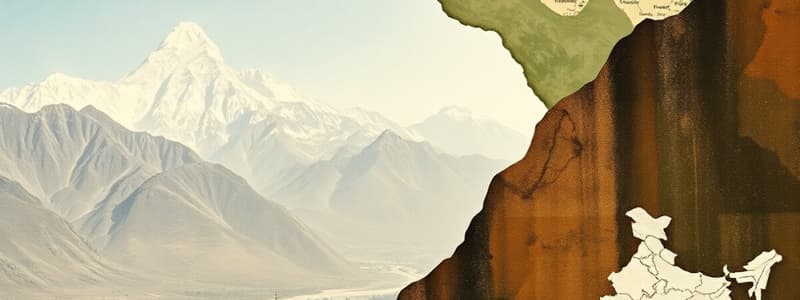Podcast
Questions and Answers
What is the primary source of water for the major river systems in the northern part of the Indian subcontinent?
What is the primary source of water for the major river systems in the northern part of the Indian subcontinent?
Which of the following is NOT a geographic feature mentioned as contributing to the unique characteristics of the Indian subcontinent?
Which of the following is NOT a geographic feature mentioned as contributing to the unique characteristics of the Indian subcontinent?
What is the primary reason for the reliance on irrigation systems in the southern peninsula of India?
What is the primary reason for the reliance on irrigation systems in the southern peninsula of India?
How did the Gomal and Khyber Passes impact the history of the Indian subcontinent?
How did the Gomal and Khyber Passes impact the history of the Indian subcontinent?
Signup and view all the answers
What is the significance of the Vindhya Mountain range in the context of the Indian subcontinent?
What is the significance of the Vindhya Mountain range in the context of the Indian subcontinent?
Signup and view all the answers
Which of the following is a consequence of the annual monsoons in the Indian subcontinent?
Which of the following is a consequence of the annual monsoons in the Indian subcontinent?
Signup and view all the answers
Which of the following BEST describes the relationship between the Indian subcontinent's geographic features and its history?
Which of the following BEST describes the relationship between the Indian subcontinent's geographic features and its history?
Signup and view all the answers
What does the text suggest about the significance of the Indus River in the development of early civilizations in the Indian subcontinent?
What does the text suggest about the significance of the Indus River in the development of early civilizations in the Indian subcontinent?
Signup and view all the answers
Flashcards
Himalaya Mountains
Himalaya Mountains
A major mountain range in Asia that includes the world's highest peaks.
Indus River
Indus River
A major river in South Asia that flows through northern India and Pakistan into the Arabian Sea.
Khyber Pass
Khyber Pass
A key mountain pass that has been used for invasions and trade between India and Central Asia.
Ganges River
Ganges River
Signup and view all the flashcards
Deccan Plateau
Deccan Plateau
Signup and view all the flashcards
Vindhya Mountain Range
Vindhya Mountain Range
Signup and view all the flashcards
Silk Road
Silk Road
Signup and view all the flashcards
Monsoon Season
Monsoon Season
Signup and view all the flashcards
Study Notes
Mountain Ranges of the Northern Indian Subcontinent
- The Hindu Kush, Karakorum, and Himalaya mountain ranges are located in the North.
- Mount Everest, the world's highest peak, is part of these ranges.
- Glaciers in these ranges feed major river systems.
River Systems and Valleys
- Rivers originating in the mountains flow into the major bodies of water: the Indus River into the Arabian Sea and the Ganges River into the Bay of Bengal.
- The Indus River flows through Kashmir and Punjab, creating fertile agricultural land before reaching the Arabian Sea.
- Early cities and civilizations developed along the Indus River valleys.
- The Ganges plains and the Brahmaputra River plains also have dense populations and agricultural areas.
Deccan Plateau and Vindhya Mountains
- The Vindhya mountain range separates the northern plains from the Deccan plateau in the south.
- The Deccan plateau is a drier region, relying heavily on monsoon rains.
- Monsoon winds, originating from the Indian Ocean, are the primary source of precipitation.
- Rivers in the south have less water flow compared to the northern rivers.
- Irrigation systems are crucial for agriculture in the southern peninsula.
- Volcanic rocks from the Deccan plateau were used in construction.
Coastal Regions and Trade Routes
- The Malabar and Coromandel coasts in the far south have lush vegetation.
- Along these coasts, societies like the Kerala and Tamil people thrived.
- Ancient maritime trade routes connected the region to the Arabian Gulf, Africa, and Southeast Asia.
- European fleets began entering the Indian Ocean from the 16th century onward.
Passes and Historical Significance
- Important passes like the Gomal and Khyber passes in the northwest facilitated travel and invasions into the Indus River valleys and Indian plateaus.
- Other passes, such as those through Chitral and the Karakorum, connected the area with Central Asia along the Silk Road trade routes.
Studying That Suits You
Use AI to generate personalized quizzes and flashcards to suit your learning preferences.
Description
Explore the major mountain ranges and river systems of the northern Indian subcontinent, including the Himalayas and Indus River. Learn about the geographical features that contribute to the fertile landscapes and ancient civilizations. Discover the vital role of the Deccan Plateau and Vindhya mountains in shaping the region's agriculture and climate.




